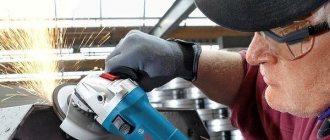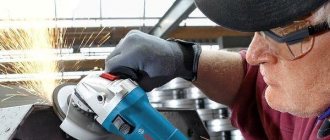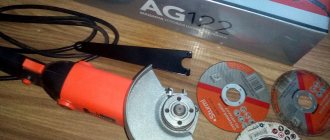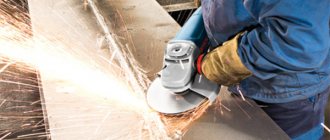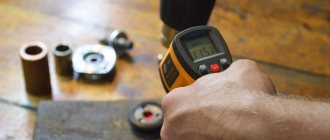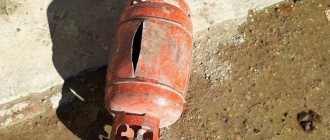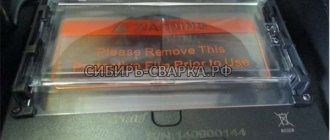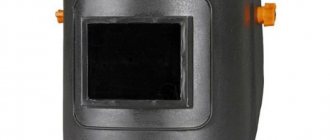Safety precautions
There are several types of protective equipment required when operating this device.
Individual protection means
A guarantee of eye safety when using an angle grinder is safety glasses . They have several varieties:
- Open type glasses. They resemble ordinary glasses for vision correction or sun protection, but have a denser structure and increased plastic thickness. These glasses protect your eyes from sparks and small fragments. Their disadvantage is their lack of protection from dust. When working with ceramics and stone, dust is generated that can cause eye irritation. In this case, the following type of glasses is suitable.
- Closed-type glasses. They fit tightly to the contour of the face and prevent dust from entering the eyes. They also protect your eyes from splinters and sparks. Some models have a ventilation system that prevents fogging of the inner surface of the lenses. This version of glasses will cost a little more, but it also has more advantages.
Glasses must be worn regardless of the nature of the material being cut or sanded.
Protective mask
Another safety device when working with an angle grinder is a protective mask .
It can be reinforced with a special mesh, which makes it stronger. This mask is much better than glasses, because it protects not only the eyes, but also the rest of the face. The main cause of injury is a split saw blade. Its fragments, flying at great speed, can injure not only the person working with the angle grinder, but also those nearby.
Principles of safe work
The presence of personal protective equipment undoubtedly reduces the risk of injury when using an angle grinder. But it is also worth remembering other safety requirements .
- Protective cover. This device must be on the angle grinder. Some careless operators remove the protection in order to put on a wheel of a larger diameter, which is not intended to work with this angle grinder. Sometimes the casing is removed in cases where it is necessary to use the grinder at an awkward angle. Such actions are unacceptable. Of course, the protective casing does not provide 100% safety, but in most cases it will protect you from injury. Recently, the protective cover for angle grinders has received a useful modification. It's called a dust extractor. From the name it is clear - this device helps direct dust particles in the opposite direction from the operator, which greatly simplifies the work.
- Hand protection. To prevent sparks and hot metal particles from coming into contact with the skin of your hands, it is recommended to use special welding gloves. Small sparks hitting the skin do not cause obvious pain. But when a large burning particle hits, it causes severe pain. At this moment, the hand may shake, thereby creating a traumatic situation. Gaiters will help prevent hot metal from getting on your hands.
- Selecting an abrasive wheel. To work with an angle grinder, you should only use a wheel that is suitable for it. If you use a circle with a diameter larger than expected, it may break without even touching
- with the cutting object. The fact is that different models of angle grinders have different speeds, and abrasive wheels have different speed resistance.
- You should also not use wheels with visible external defects, such as chips, deep scratches or cracks.
- It is forbidden to install a disk on the grinder for sawing wooden products. Firstly, it is dangerous - the saw blade may encounter a knot, which can cause the tool to be torn out of your hands. Secondly, the disk will very soon become unusable, because it is not adapted to such a load. The speed of a circular saw is much lower than that of an angle grinder.
- Sawing object. If the element being processed is small in size, you need to secure it with something. The best option for this would be to use a vice. It is strictly forbidden to saw the product with one hand while holding it with the other. In this case, the sawing element may be torn out of your hands.
If the product is large and installed motionless , it is necessary to ensure that the abrasive disc does not bite. General rules:
- Always unplug the angle grinder when replacing a blade. This is to prevent accidental startup.
- When choosing an abrasive disc, give preference to a trusted manufacturer.
- When working, make sure that the power cord is kept away from the sawing wheel.
- When using an angle grinder, avoid the possibility of hair and clothing getting wrapped around the rotating disc.
How to hold an angle grinder while working
The correct grip of an angle grinder will largely ensure competent and safe work with the tool:
- The handles of the grinding machine must be held firmly with both hands , without transferring its center of gravity to any one. With a secure grip, even in the event of a reverse strike, there will be no serious displacement of the tool, much less tearing it out of your hands.
- The power cord must be positioned away from the rotating blade ; getting caught in it will create a risk of short circuiting and causing the tool to stop abruptly, possibly causing kickback.
- The cutting line should be positioned in such a way that the grinder faces the master, and the person should not be in the plane where the disc is likely to fly apart . In this case, the direction of the sparks is possible both away from the master and under him - everyone decides for himself. There are no options for left-handed people - when gripping an angle grinder, the only way convenient for a left-handed person is that the sparks will flow “under themselves”. And a mandatory rule is that there should always be a bucket of water nearby to extinguish a possible fire caused by sparks.
- It is forbidden to put the tool down anywhere until the rotation of the working disk is completely stopped , otherwise objects and planes not intended for processing may become caught.
- If you need to move the grinder from one place of work to another, you should turn it off , since any careless movement of the master (stumbled, swayed, fell) can lead to unpleasant consequences: injuries, seizure of foreign objects, clothes, etc.
- The working disk heats up significantly during work, and, of course, you should not touch it until it cools completely .
The best way to protect your face while working with an angle grinder
An angle grinder, better known as an angle grinder, is a serious and dangerous tool. But it is quite difficult to do without the use of angle grinders during construction and even minor repair work. The use of an angle grinder reduces labor costs and speeds up the process. Therefore, when working with angle grinders, it is extremely important to follow safety precautions. One of the significant points is the protection of the face, because sparks, scale, small particles of metal, grinding disc and other materials can damage the skin and mucous membranes.
Protective glasses
A popular means of protection when working with an angle grinder is special glasses. They come in two types: open and closed.
- Open glasses look like regular ones, but are made of dense materials that can withstand sparks and small debris. Unfortunately, such glasses will not help when working with hard materials, and will not protect you from dust;
- Closed-type safety glasses adhere completely to the skin and prevent dust and any elements from entering the eyes.
Both options have a significant drawback: the glasses do not completely cover the face and are aimed only at protecting the eyes.
Types and features of using angle grinders
The popularly known grinder is nothing more than an angle grinder. This power tool, according to ordinary people, is necessary for every owner who has the slightest bit of self-respect.
It is not surprising, because in addition to grinding, the device is capable of performing high-quality cutting of various types of materials, ranging from simple wood to metal corners and fittings.
Most often in everyday life, this tool is used not for grinding operations, but specifically for cutting materials.
Subtleties of using power tools
Before you learn how to make an even cut, you need to figure out how to use a household grinder correctly so as not to damage yourself.
But you shouldn’t ignore the instructions, because an angle grinder is not only a useful tool on the farm - an angle grinder is also extremely dangerous in the hands of an inexperienced operator.
There are frequent cases of serious injuries to the face, limbs, and torso due to careless handling of the device. Eyes are even more likely to suffer from scale, sparks and other foreign objects if they are not properly protected.
Moreover, no one is insured against an accident - even experienced users who have been working with an angle grinder for 20-25 years, by coincidence, find themselves visiting the emergency room.
Therefore, it is important, first of all, to protect yourself with personal protective equipment (PPE).
Protective shields
Special shields, or masks, for working with an angle grinder seem to be more reliable, but their cost is higher. Professionals prefer this category of protective equipment, because they protect not only the eyes, but the entire face. Masks come in different types and are made from different materials, which affects their appearance and cost.
The masks are attached using special belts or other fasteners and are held tightly on the head; the protective glass protects against the ingress of scale and dust particles and materials. Some shields have a visor that protects the forehead. In addition, shields are made with a special fine mesh - this is additional protection, including from damage to the mask itself during operation, which increases its service life. Overall, a face shield is more durable than regular glasses.
OCCUPATIONAL SAFETY REQUIREMENTS AFTER WORK COMPLETION
5.1. After finishing work with a manual electric machine of the “Bulgarian” type, it is necessary to disconnect it from the electrical network using the plug connector. 5.2. At the end of the work, the manual electric machine and the personal protective equipment used should be cleaned of dirt, dust, sawdust and put in order. 5.3. At the end of the work, you should take off your overalls, safety shoes and other personal protective equipment and put them in the designated storage location, and, if necessary, hand them over for washing and cleaning. 5.4. Any malfunctions or other violations of labor safety requirements noticed during work must be reported to your immediate supervisor and measures must be taken to eliminate them. 5.5. At the end of work, you should wash your hands thoroughly with warm water and soap, and if necessary, take a shower. 5.6. Leave the territory of the enterprise along specially designated paths.
What to look for when choosing a protective shield
The safety of your face and eyes directly depends on the quality of the mask. Saving in this case can become deadly.
- You should choose trusted manufacturers with a reliable reputation;
- The mask must be equipped with a steam exhaust system to prevent fogging;
- The most durable materials: polycarbonate and polystyrene. They are usually chosen by professionals;
- The most important functions of the shield are impact resistance and heat resistance. These qualities are worth paying attention to first;
- Shading is an important element of a proper mask. In case of sharp flashes, a poor-quality light filter will lead to damage to the retina;
- If you have to work frequently and regularly with an angle grinder, then it makes sense to think about purchasing an elongated mask - this type will help protect not only your face, but also your neck.
Step-by-step instructions on using an angle grinder
Having dealt with PPE, let’s look at how to cut correctly with a grinder – sparks “towards you” or “from yourself”. More details about the direction of sparks later in the article.
True, this point is the subject of heated debate among numerous angle grinder owners. And each user provides compelling arguments in favor of their point of view. But they agree on one thing - you need to work in such a way as to protect yourself as much as possible.
Let's look at step-by-step instructions for working with an angle grinder.
Step #1 - Cleaning the Workplace
Before starting work with an angle grinder, you should remove as much as possible everything unnecessary in the work area - bars, buckets with solution, coils with cables, plastic film and other useful things.
Keep other people away from the power tool while it is in operation to prevent them from being accidentally harmed by sparks and dust. If, due to the specifics of the process, there are assistants present, they need to put on PPE and move a safe distance from the operator
There should be nothing unnecessary under your feet or on the working surface that the grinder could accidentally get caught on.
Step #2 - preparing the material for work
An equally important stage is the preparation of the material. To avoid problems with angle grinder processing, you need to securely fix it. To do this, use a vice, clamp, clamps and other devices that can hold a board, corner, pipe, etc. in place.
If you have to work with concrete or cinder block, it would be a good idea to moisten it, which will reduce the amount of dust generated
You cannot use parts of your body – arms, legs, torso – as holders. Also, you should not involve an assistant who will support the pipe or brick in the desired position - if the tool gets out of control, the consequences will be disastrous.
Step #3 - preparing the tool for use
The process of preparing an angle grinder should begin with the selection of the necessary attachment - recommended by the manufacturer for a specific task.
It is important to carefully inspect the selected disc from all sides and if any cracks, nicks, chips or other problems are found, discard it immediately.
As a rule, branded angle grinder models are equipped with several types of devices:
- universal cutting wheels;
- diamond bits for cutting durable materials;
- circles for working on concrete;
- different types of grinding attachments;
- metal brushes.
The number and range of additional accessories depends on the model purchased. Often, universal circles have to be purchased separately, and their cost is quite high.
For comfortable operation of the grinder, you can use additional accessories. It's a pity that not all manufacturers supply them as a set.
Image gallery
Photo from
Water supply implemented
Protective cover with nozzle for vacuum cleaner
Clamp for holding the processed material
Additional protective accessory - casing
The set of additional accessories depends on the angle grinder model and its capabilities. The manufacturer must inform owners about this in the instructions. Moreover, it prescribes what is strictly forbidden to do.
No less important is the diameter of the cutting wheel and the recommended rotation speed - the number of revolutions per minute should exceed this parameter for an angle grinder. You should not install large nozzles - there is a risk of injury.
All work on changing the disk must be performed with the device completely disconnected from the network.
The correct installation of the disk is demonstrated in the operating instructions. Moreover, some branded electrical appliances provide only one option for placing the cutting disc.
Step #4 - initial launch and testing
If the process of preparing the tool is completed and the desired disk has taken its place, let’s consider how to properly and safely hold a working grinder in your hands.
This point is especially useful for beginners who do not yet have experience using an angle grinder. First you need to properly pick up the machine and take a stable position.
Firstly, take the device in such a way as to ensure that the “spark is directed towards you” - this is a symbol for the position of the angle grinder.
The plane of the circle is located strictly parallel to the plane of the user’s body, and the head is strictly outside the plane of the same circle.
When the tool faces in the direction opposite to the operator, it will cut, and accordingly, the disk will move in the same direction - away from the operator. But the sparks need to be directed downwards to the left of the operator by adjusting the casing
Secondly, the additional or auxiliary handle screwed to the body of the angle grinder must be occupied by the right hand. This is for a right-handed person. The point is to have a strong hand guide and control the movement of the tool.
Thirdly, the on/off button and power adjustment are controlled by the left hand. Which holds the device by the handle on the body, if there is one.
The button is usually located in a convenient place on the case - right under your fingers. This allows you to instantly turn off the grinder as soon as the circle starts to jam
As for the angle grinder, it must be positioned to the left of the operator’s body, without touching the latter. Body position – legs stand firmly on a hard surface, right shoulder and arm lean forward.
In this position, you need to practice idle so that your arms and legs get used to the desired position.
Then you have to turn on the grinder and wait about a minute for the disc to accelerate. After this, you can proceed directly to work.
Step #5 - Perform cutting or sanding
If this is your first time picking up a power tool and you don’t know how to properly cut a metal pipe with a grinder, don’t worry. First, carefully read the manufacturer's recommendations and only then start cutting.
Branded angle grinders are necessarily supplied with additional devices, attachments and accessories intended for use with the purchased machine. There is also an instruction manual that specifies which disc to wear for which work.
When cutting, you should hold and guide the tool, avoiding excessive pressure on the handle. Cutting is performed using the edge of the nozzle. Moreover, jerking and sudden movements are contraindicated - such behavior of the grinder is fraught with failure of the cut.
It is also important to control the depth of the circle’s entry – it should not be large. The less the nozzle is immersed in the material, the less wear it will have. And the less danger of getting stuck in the cut.
When performing grinding, it is important to use strictly designated equipment. These are special wheels - cleaning wheels. They most often come with a casing that will prevent the scattering of small particles that appear during the surface cleaning process.
When grinding a certain area, it is important to maintain an inclination angle of 20-40 degrees between the disk and the surface being sanded. But you can’t grind with the end of a diamond wheel - it can explode and fly apart
If you are cleaning with circles with metal bristles, then you need to be extremely careful with them - such a harmless attachment during the processing of the part loses pieces of bristles that fly in different directions and can injure parts of the operator’s body, piercing protective clothing.
Safety precautions when working with angle grinders
Compliance with solid waste is the key to safe work and high-quality results without negative consequences for health and life.
- Using a protective shield when working with an angle grinder is an important component of the process that cannot be ignored;
- In addition to the mask, before work, put on protective gloves and a suitable suit (preferably a special one) to protect not only your face, but also the rest of your body;
- For each type of material, use only a specially designed disc;
- Check tool fastenings and guards before starting work;
- Before work and after changing the attachment, check the tool at idle speed;
- Work in a comfortable and stable position;
- The most dangerous thing when working with an angle grinder is the rupture of a disk rotating at high speed. Splinters can cause fatal damage, so it is extremely important to purchase high-quality protective materials and use the machine in accordance with safety precautions.
Under no circumstances remove the protective casing from the angle grinder to lighten the weight of the tool!
Remember, life and health are the most important. Do not neglect safety precautions and use protective equipment to avoid damage to the skin and eyes.
The principle of woodworking
The angle grinder was originally designed for polishing and sanding surfaces, and therefore it can easily cope with operations on wooden workpieces. At the same time, there are some nuances and rules of work that will not only protect the craftsman, but will also help him better cope with wood processing.
First, you should dwell on the types of nozzles, among which are:
Attention! respirator, benefits and harm.
- Sanding pads are a multi-layer compound disc where rubber and plastic alternate with foam rubber, sandpaper or wool flannel. The structure helps to extend the life of the wheel and polish the surface.
- Flap discs are designed for rough processing of wood at the initial stage. Sandpaper petals of different grain sizes are attached to the surface of the circle, which polish the surface, removing all imperfections.
- A wire brush is used to remove old paint from a wooden surface.
Operations involving polishing or sanding wood are considered relatively safe. During operation, the disc does not get stuck in the cut, there are no jerks, short circuits or deformations of the wheel.
Protective agents used
The following personal protective equipment must be worn by the user while operating the angle grinder:
How to choose a respirator
- protective mask or goggles covering the eyes on all sides;
- gloves made of thick fabric or leather;
- special shoes (intact, durable) and work clothes;
- respirator , which will provide protection against the penetration of small particles into the respiratory system when cutting concrete, glass or ceramic tiles, brick, porcelain tiles, foam blocks, stone and other dusty materials.
To work with an angle grinder, the use of protective equipment is mandatory. This helps you work more safely.
Proper starting, stopping and breaks
Before turning on the device, you should carefully inspect and thoroughly check the disk. Do not use attachments with chips, delaminations, cracks or any other damage.
Before connecting it to the network, you need to install a cutting (grinding) wheel on the grinder with the pattern facing up, then tighten it with a special nut. The size, as well as permissible speeds, are indicated in the technical documentation for the tool.
A discrepancy between the characteristics leads, at a minimum, to faulty operation, premature wear of the disk, and in the worst case, to injuries.
When inspecting the tool, you need to check that:
- there are no damages or cracks on the body;
- serviceability of the cable (cord), protective tubes and plug;
- the handle is screwed well;
- the circle is fenced and the casing is securely fastened.
After this, operation of the tool is checked. To do this, you need to connect the plug to the socket, turn on the power button and the latch. Watch the grinder at work for a minute.
Make sure that it operates without extraneous sounds, excessive vibration, and that the disk does not touch the protective casing. When disconnected, the malfunction or functionality of the power button and latch will become clear.
If everything is fine, you can start working.
To take a break from work, you need to turn off the power with the button, wait until the disk stops completely, put the grinder down and turn it off from the network.
Breaks in work are usually associated with overheating of the disk or grinder, replacement of attachments, or the need to move the parts being processed or the worker himself. In any case, you must first turn it off with the button, and then disconnect it from the network. It is important to monitor the tool and prevent it from overheating.
How do safety glasses work?
The means under consideration include the main and fastening parts. The main part is presented in the form of protective glasses and fastenings for them, and the fastening part consists of arms or straps. Glass is the base that provides reliable protection for the eyes. Fastening is mandatory, since the ease of use of protective equipment depends on the quality of fastening.
Additionally, safety glasses may include:
- Ventilation holes
- Arm Length Adjusters
- Fasteners of different types of fastening
- Gaskets made of rubber and fabric base
What is protective glass for such products made from? Various materials are used for this, namely:
- Glass with impact-resistant properties. The use of glass in the product provides more advantages, since visibility reaches 100%
- Polymer materials, since glasses made of polymers are popular because they are cheap, but any scratches on the surface distort visibility
- Plastic, such products are popular in cases where there is a risk of not only sparks and small particles getting into the eyes, but also shavings or splinters
- Silicone is a material that began to be used not so long ago for the manufacture of safety glasses. Its characteristics can be compared to plastic.
Types of safety glasses
Safety glasses are used not only for working with an angle grinder, but also when turning on a grinding machine, where the risk of small particles getting into the eyes is no lower than when operating an angle grinder. The products under consideration are divided into two types according to the degree of protection:
Closed-type glasses protect your eyes not only from small particles, but also from dust, smoke and even chemical formations. To secure this type of protective products, manufacturers offer special fastenings in the form of straps with clamps. The presence of a special regulator allows you to use glasses for different people. When using closed-type products, a phenomenon occurs such as the formation of condensation on the inner surface of the glass. To eliminate the occurrence of condensation, manufacturers have modernized their products by equipping them with special types of spraying. If the product is equipped with ventilation, the cost of such devices increases several times.
Open-type glasses are ordinary products that have special impact-resistant glass. They protect the eyes from direct contact with sparks and particles, but are not able to prevent the entry of smoke and dust. The disadvantage of such products is that when using them, you need to select a specific model according to the size of your head. Only the temples are used to secure the glasses on the head.
Both types of protective devices use different glass materials. Depending on how often you have to use an angle grinder or sandpaper, you need to make the appropriate choice regarding the closed or open type of protective devices.
How to work safely with an angle grinder?
When everything is more or less clear with universal safety points, it is time to look at specific examples of work and the protection of the operator when performing them. For greater clarity, the information is presented in the table. The data is systematized by main points.
So, most often a grinder is used for cutting ceramic tiles and performing tasks on metal and wood. More about this below.
Attention! Manufacturers do not recommend using an angle grinder for working with wood due to the increased risk of injury!
Main types of grinders
This useful and almost universal power tool can not only saw and cut, but also grind the surface with emery wheels, clean off rust with metal brushes and, if you have a special diamond wheel, carefully cut glass.
READ Sharpening Chainsaw Chain for Ripping Sawing
Attention! respirator, benefits and harm.
But not every angle grinder model has a wide range of capabilities. And technical characteristics, such as power, revolutions per minute, recommended disc diameter and the list of possible operations, vary.
In addition, all grinders presented on the power tool market can be divided into the following categories based on operating time and endurance:
- For domestic use - this type involves use strictly at home to perform simple tasks. The operating time of such models is up to 40 minutes.
- For professional use - this category of power tool is designed for a daily load of 3-4 hours. Similar models are used by craftsmen performing “turnkey repairs” and other types of repair work.
- Industrial - machines, it’s even awkward to call them simply “grinders,” designed for continuous use by an angle grinder operator all day long.
While the first two types are common among the population, the latter are used exclusively in large enterprises working with serious objects. And increased demands are placed on an employee applying for the position of operator.
In particular, knowledge of the design of a power tool, the principle of its operation, the technology of performing work with its help, and knowledge of and compliance with personal safety rules.
In addition, devices can be classified according to the type of power supply: mains-dependent and rechargeable. And also divide into groups according to cost and other criteria.
Comparison with protective masks when their use is necessary
Masks are analogues of protective devices. When working with an angle grinder, using a mask is important when you have to work with the tool for a long time every day. The first difference between a maxi and glasses is its size. It protects not only the eyes, but also the entire part of the head. Masks for working with an angle grinder are in demand when an angle grinder is the master’s main tool.
The second difference between the mask is its cost, which is several times higher than the price of the devices in question. Often masks are additionally equipped with protective nets over the glass, which allows for maximum protection of the face and head as a whole. When using an angle grinder, it is important to follow safety precautions, which will allow you to complete the work you started without getting injured.
Tips for choosing the right glasses for working with an angle grinder
When choosing the products in question, it is important to pay attention to some important points. These points include:
- The material from which the product is made. You need to choose models that have a high degree of protection. The presence of glasses on the nose when working with an angle grinder does not mean that the person is completely safe
- Availability of auxiliary protection against ultraviolet radiation. If your job requires you to work every day in the sun with an angle grinder, then it won’t hurt to purchase safety glasses with a special coating against ultraviolet radiation. Models called “Chameleon” are popular.
- Ventilation. If you prefer a closed type of product, be sure to make sure that the devices are equipped with ventilation. If the product does not have such a function, then you will need to remove the glasses very often to remove condensation from the inside of the glasses
No one can take care of a person’s own health except himself. In order to work with such a dangerous tool as an angle grinder without injuries or other incidents, you need to take a serious approach to the choice of protective equipment. If you do not follow safety rules, even an experienced specialist can get injured.
How to work with an angle grinder correctly: safety precautions, instruction manual
Are you planning to use a power tool while doing home repairs, but don’t know how to work with an angle grinder correctly so as not to injure yourself? Agree, it would be unwise to unknowingly break a disc in the first minutes or, even worse, injure yourself.
Or have you just decided to acquire a power tool and are studying the rules of its operation in advance? In this case, pay attention to the products of famous manufacturers with a good reputation, who sell really high-quality devices of excellent assembly with a long-term guarantee.
After all, it is safer to work with a reliable tool. One of the excellent options is products from the Bosch, DeWALT, Makita brands, as well as Metabo angle grinders sold in the Moyo network in a wide range. We will look at the operating rules and main mistakes when working with this type of power tool in detail in our article.
The material, in addition to recommendations for using an angle grinder, contains visual photos of working with an angle grinder and useful video tips from experienced users. Having familiarized yourself with the latest and observing the rules of personal safety, you will be able to cope with the chiselling of a concrete wall, cutting tiles or bricks on your own, without involving specialists for these tasks.
Design features of safety glasses
You can divide all existing safety glasses into several groups. The distribution occurs according to the type of material, design features and coverage area.
By lens material
Several materials are used to create protective glasses lenses. The most common of them are:
- Mineral glass. It has been used since the days of the USSR. The main advantages of the material are its high light transmittance and resistance to light impacts (damage, chips, scratches). The main disadvantage is the fragility of the product and the possibility of injury from chips.
- Organic glass (plexiglass) and plastic. The ability to transmit light of these materials is lower than that of mineral glass, but they are much more flexible. This allows you to withstand fairly strong impacts, and in the event of breakdowns, fragments practically do not appear. But due to a large number of scratches on the surface, the material may become matte, which will make it unsuitable for use. Therefore, the service life of glasses made of organic glass and plastic is not so long. Also, these materials are easily destroyed when exposed to chemicals and at high temperatures (200 degrees).
- Silicone. This material is the most flexible of all listed. It can easily withstand even very powerful blows, but does not cope well with minor damage. Silicone also quickly deteriorates when exposed to high temperatures (sometimes it can withstand up to 300 degrees, but most often it begins to lose its properties at 200). The surface becomes cloudy over time, so the service life is also quite short.
Tips for choosing the right glasses for working with an angle grinder
When choosing safety glasses for working with an angle grinder, special attention is paid to certain details. These include:
- Case material. To protect your eyes, choose a model that can reliably protect your vision. The presence of a thin frame with glass does not guarantee the safety of the operator.
- Additional protection against ultraviolet rays. If you work with an angle grinder often in the fresh air, it requires the presence of sunlight. To protect your eyes from bright rays, it is better to buy protection with a special coating against ultraviolet radiation. “Chameleon” models have become widespread among craftsmen.
- Ventilation. If a closed model is used when working with an angle grinder, pay attention to ventilation. When there are no holes on the surface, you have to often remove the protection and wipe off condensation.
- Price. You can't skimp on quality. If, when purchasing, it is clear to the naked eye that a cheap model will quickly deteriorate, it is better to buy a more expensive one.
- Convenience. Immediately upon purchase, the model is tried on. The frame should not be too tight or restrict movement, or fall off the ears. Otherwise, you will have to be frequently distracted while working, and this can lead to serious injuries.
Important! No one except the operator will take care of eye protection during operation. To ensure tasks are completed quickly and with pleasure, safety precautions are followed.
Care and storage rules
Most models, even made from durable material, quickly wear out and fail. Therefore, before each use, you should carefully inspect the frame for damage. If there are severe chips, deep cracks and scratches on the surface, and the elastic band is stretched and loose, it is better to purchase a new model.
To remove adhering dust and dirt, the surface should be periodically wiped with a piece of damp cloth. The hardware store sells special material impregnated for disinfection. It is better to store the protection in a special case that protects it from damage.
To work with an angle grinder, special safety glasses are used. They protect the organs of vision from foreign objects and dust. There are many models on sale, among which it is not so easy to choose the right glasses. When purchasing, it is better to rely on the material of manufacture, price, ease of use and other characteristics. The more carefully you care for your safety glasses, the longer they will last.
Device and capabilities
All grinders, regardless of manufacturer, are made the same way. The difference may be additional design elements through which the brand wants to stand out. A standard grinder (for example, Makita GA5030) consists of:
- durable shock-resistant case that is not afraid of falls;
- an electric motor, which includes a rotor, stator and electric brushes;
- gearbox and coupling;
- two handles for holding the machine;
- lever for quick disc replacement;
- button that starts the engine.
Often this button operates very smoothly, which allows the angle grinder to gradually pick up the pace, thus reducing the load on the motor and reducing the risk of possible injury.
The functionality of an angle grinder depends on the size of the machine itself and the diameter of the disc. So, if you need to perform a large amount of work, for example, clearing an impressive area of concrete, you need to select a disk with a maximum diameter (indicated in the technical specifications of a particular model). There are also universal cutters: almost all angle grinders can work with an attachment for an internal hole diameter of 22-23 mm.
Important: the larger the disk, the slower its rotation, that is, the work itself takes longer. True, modern tools are equipped with the ability to regulate the number of revolutions. This functionality is especially useful when cleaning or grinding surfaces.
